Fossil fuels are dark and patient…
— Kathryn Yussof, “Queer Coal”1
What more possibly needs to be said about coal? As the world digests the latest report from the UN’s Intergovernmental Panel on Climate Change—informing us that a future of ecosystem collapses, coastal inundations, and food shortages due to global warming will be arriving as soon as 2040—the facts around coal’s participation in that warming remain as clear as ever.2 To cite but one among a litany of statistics that make the case, in the United States, coal emissions last year accounted for over two thirds of carbon dioxide emissions from the electric power sector while providing less than one third of its electricity.3 Would that it was only CO2 being emitted. Mercury, nitrogen oxide, and good old-fashioned soot are plentiful in the mix, killing tens of thousands in the United States (the figure is something closer to a million people worldwide) yearly.4 And would that coal’s environmental effects were only atmospheric. Underground mining was hardly gentle on the earth, with overburden, tailings, and slurry ending up in surrounding streambeds, and the rise of mountaintop removal has accelerated the devastation of US landscapes, notably in Appalachia, since the 1970s—the era, ostensibly, of the Environmental Protection Agency.
In response, a familiar alliance of cynical politics and industrial profiteering offers the figure of the out-of-work coal miner, a proud but benighted character who has taken on an outsize role in recent political discourse, whether in the guise of MAGA rallies, J. D. Vance’s Hillbilly Elegy, or the empathy-for-the-Trump-voter genre of journalism, which sometimes finds in the former coal camp a narrative peg despite its statistical near-irrelevance where presidential politics are concerned. This is an imagined geography of coal’s decline as much as a real one; while Wyoming’s Powder River Basin now accounts for 41 percent of US production, this is a fact seldom raised in coal’s political mobilization, with the plight of principally Appalachian coal towns, “coal country” as we know it, being used to bolster the profits of extraction undertaken elsewhere.5 The slogans need not be amplified here, but it suffices to say that promises to restore coal employment have proved as false as everyone always knew they would be. Renewables and natural gas continue to gain economic ground. The mechanization (from the 1920s onward) and then mountaintop removal methods (principally since 1970) that have decimated employment—863,000 miners in 1923; 500,000 after the Second World War; 164,000 by the end of the Reagan administration; 55,000 today—aren’t going anywhere.6 The coal sector added some 2,000 jobs since the last presidential inauguration, thanks in part to temporarily increased exports after the disruption in Australia’s coal mining after Cyclone Debbie, little more than a bump in a stark decline.7 In return for those jobs, touted with a characteristic lack of proportionality, the administration has stripped worker protections, undone environmental regulations, enacted tax cuts for the wealthy, and ignored pressing questions of health crises and economic vitality in Appalachia as elsewhere. Perhaps most notably, that administration has continued to mobilize white grievance—within Appalachia, sure, but more substantively by deploying “Appalachia” as a figure of thought that sends signals outward to a nation suffused with all of the supposed backwardness that we’d like to pretend is safely sequestered in the mountains—as an alibi for bolstering American oligarchy.
You know this already. So does Appalachia. Elizabeth Catte’s What You Are Getting Wrong about Appalachia marks out the many exclusions in the popular narrative around a region that has never been as conveniently uniform (racially, culturally, politically, environmentally, historically) as the overarching narrative asks it to be, while looking unflinchingly at the ongoing struggle for the region’s future. She closes by plumbing the potentials but also the limits of the “deeply satisfying yet problematic” model of Appalachia as an “internal colony,” one that offers “a tool for understanding the region’s web of exploitation…which allowed us to transform our shame into coherent and righteous anger,” a much-needed galvanizing force for an activist stance (even as it elides the colonization of indigenous lands and the potential complicities of Appalachians within these dynamics of capital imposed from without).8 She then turns to a New Deal photograph from Haysi, Virginia, of a happy couple in a photo booth, in which she notes the powers of representation to upend the clichés that define most people’s ideas about the region. “Whatever happens next for Appalachia,” she writes, “there are people here who deserve similar moments of liberation from their pain and shame, to see their lives and history as something other than an incoherent parade of destruction and wretchedness.”9
So, again: What more needs to be said about coal? As its burning is consigned to history—and perhaps the energy sector might “make coal history” sooner than later, to borrow an activist slogan, though no matter how much or how little carbon habits are curtailed today, the burning of coal will someday be historical—it might be opportune to attend to the phrase’s second connotation. What forms will that history take? Where will its archives be kept, and what goes in them? Can they illuminate that complex “web of exploitation” that has shaped the region for the past 150 years? What of the places, and the people, involved in that history? How might atmospheric data, settler colonialism, labor struggles, geology, extractive corporate capitalism, folk culture, and a remarkable landscape be read through one another? With questions like these on my mind, in August 2017, I took a road trip to visit the coal museums and exhibition mines of Virginia, West Virginia, and Kentucky, to think about the sites of coal’s historicization that are already on and in the ground.
Looking down from a satellite, the Appalachians are most visibly a raked smudge swooping southwest from Pennsylvania to north Georgia. These are the “ridge and valley” Appalachians. North and west of that—eastern Kentucky, western Pennsylvania, the entirety of West Virginia—is the Appalachian Plateau. These hills were formerly as rugged as the Rockies but have long since been nubbled down by erosion and time. When you’re in them, they feel mountainous enough. When you look at the region as a topographic model, with distance, they look more like a forested piece of aluminum foil that was balled up and stretched out again, high slopes locally but a relatively low relief across the whole. It’s on the plateau that about a third of US coal is produced.
I borrow a family car and head north on US 460 from Blacksburg, Virginia, passing Coal Bank Hollow and climbing up and over Brush Mountain. You probably wouldn’t think of this as coal country today, though the nearby mines at Merrimac are said to have supplied the coal that stoked the Civil War ironclad by the same name, with mining continuing into the 1970s. If you make this drive, or really any other in the region, Keith Frye’s Roadside Geology of Virginia makes a welcome companion. “Why is that hill?” he asks, alerting you here to the Silurian sandstone ridges familiar to Appalachian Trail through-hikers and the Pleistocene fossils, snails, reptiles, and mammals alike, dug out of the limestone quarries nearby.10 Around Pembroke, 460 sidles up to the New River to borrow its patient carves through the mountains. The river was here before the Appalachians uplifted during the Alleganian orogeny some 250 million years ago, and the river kept flowing across them the whole time. This is what made some towns along the New River, like McCoy, an inviting site for mining—it occupies a similar gorge farther south where the striations of geology were more or less exposed, giving relatively easy access to the seams of coal.
Every foot of coal, they say, is ten thousand years of plant material, pressed down for hundreds of millions more, from the Carboniferous period. The word means “coal-bearing,” marking one end of coal’s presence in the geological record, our present era marking the other. (Not all plant material is so obliging—tree trunks petrify into what miners call “kettle bottoms,” and their smooth sides allow them to drop out of the roof of a mine without warning.) The river’s section cut through the mountain is one way of spatializing something like geological time, a sedimental history that documents the tens of millions of years that the river wore its way through the lifting mountains and the hundreds of millions of years that those channeled-through rocks represent. The coal trains and 460 both slip through a spectacular gorge around Narrows, Virginia. The ridge the river crosses through marks the state line, more or less, as well as the beginning of the plateau.
Another hour and I’m in Beckley, West Virginia, at the Beckley Exhibition Coal Mine. I spend some time walking the grounds, which host a series of buildings relocated to this more urban environ from surrounding coal camps—a superintendent’s home, a coal camp church, a miner’s cottage, and so on. The exhibits of the museum include a miniature recreation of the company town of Putney, West Virginia, built by a former resident named Richard E. Howard. Virtually every coal museum I visit has a model town like this, if rarely as precise and imaginatively built as this one. The innate charm of such installations is reliably darkened by the narratives on the museum walls, tales of punitive and grueling working conditions alongside the corporate control of every facet of company-town life. Telling the history of coal camps is typically meant to assure the visitor that “things aren’t like that anymore”—which they are and aren’t—but the effect is that of a remembrance of the capital’s historical hegemony in the region’s extraction economies, a useful thing in its own right.11 The lyrics of the folk music of coal country, likewise, are too vivid to be forgotten, and they figure prominently as cultural artifacts in all such museums, songs that remember lives lost and stake out the battle lines in an ongoing appropriation of people and land.12
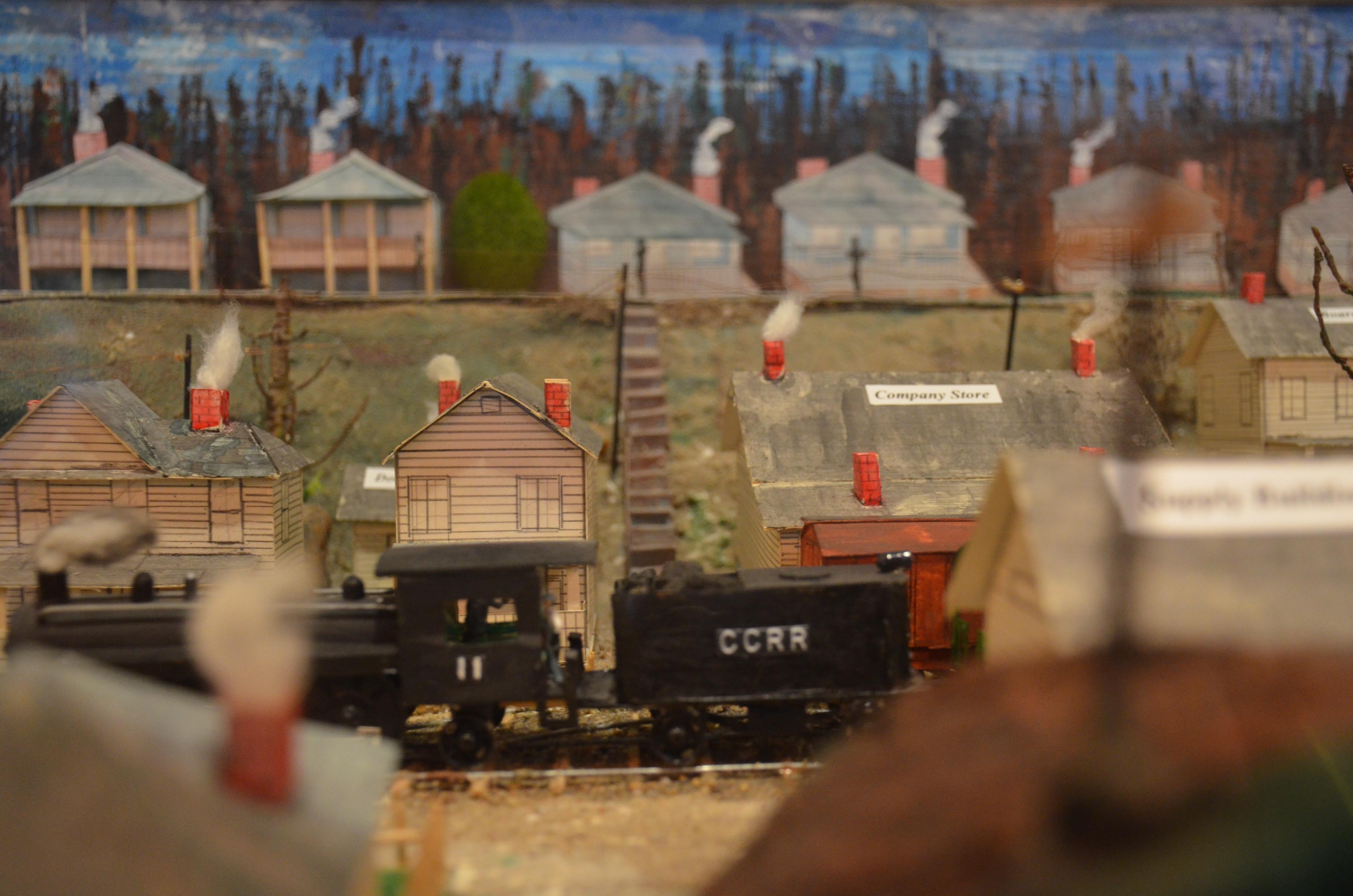
But the star of the show, here as elsewhere, is the exhibition mine, one of the stranger genres of geological attraction—a journey into “the past and future of mining in West Virginia,” as the state’s tourism office puts it, though the future of mining, whatever course we take as a country and a planet, will look nothing like this. The seam is high enough to walk into, though not reliably high enough to stand upright, so our tour, about ten of us, rides in on a mantrip. It is piloted by the genial Curt, a voice of firsthand experience, who notes that miners working “low coal”—the term referring to the thickness of the sedimentary layer being mined—can make do with just eighteen inches in height. It is always fifty-eight degrees and damp. Inside the mine are carved-out rooms, almost diorama-like, with equipment from different periods of coal mining, a history of labor told through its tools. Curt is a marvelous font of facts, stories, and colloquialisms. He sparks up a carbide possum light, shuts off the main lights, and as we sit there in the almost-black depths, he tells us just how many feet of rock are sitting on top of us. I am not the only person on the tour, when the lights come back on, who looks to have undergone an existential experience. The flame provides illumination and also checks for methane—if it burns white or blue you’re fine; if it yellows, there’s methane in the air. They’re called possum lights because of the tail on which it hangs from the beams.
The first exhibition coal mine to open in the area is an hour south in Pocahontas, Virginia. The Norfolk & Western made it here in 1883, tracing the same New River gorges I drove through on the way there, and owns the mineral rights to the area. After working through its seam, Pocahontas No. 1 was opened as an exhibition mine in 1938. The town’s population was already diminishing then, and after the fabled Pocahontas No. 3 (a preferred supplier of the US Navy) shut down in 1954, its population would soon be less than a quarter of its peak. The modest downtown invites the journalism of ruination that pervades so many visits to coal country—on my visit, a stray hound wandered an almost entirely vacant Main Street, and the sides of some of the abandoned buildings are still marked by the floodwaters of the Laurel Fork that crested here a few years prior. Many residents now work for the Pocahontas State Correctional Center, located just south of town on a decommissioned strip mine, a frequent and lamentable answer here and elsewhere to “revitalization” in remote locales. The museum itself, which I browse as I wait for the mine to open, is an archive waiting to be mined itself, replete with ledgers and scientific materials (and semi-functional models of various coal infrastructures, preparation plants, coal tipples, and switching yards, courtesy of regional vocational schools), alongside the surplus objects and bric-a-brac that typically stuff such places.
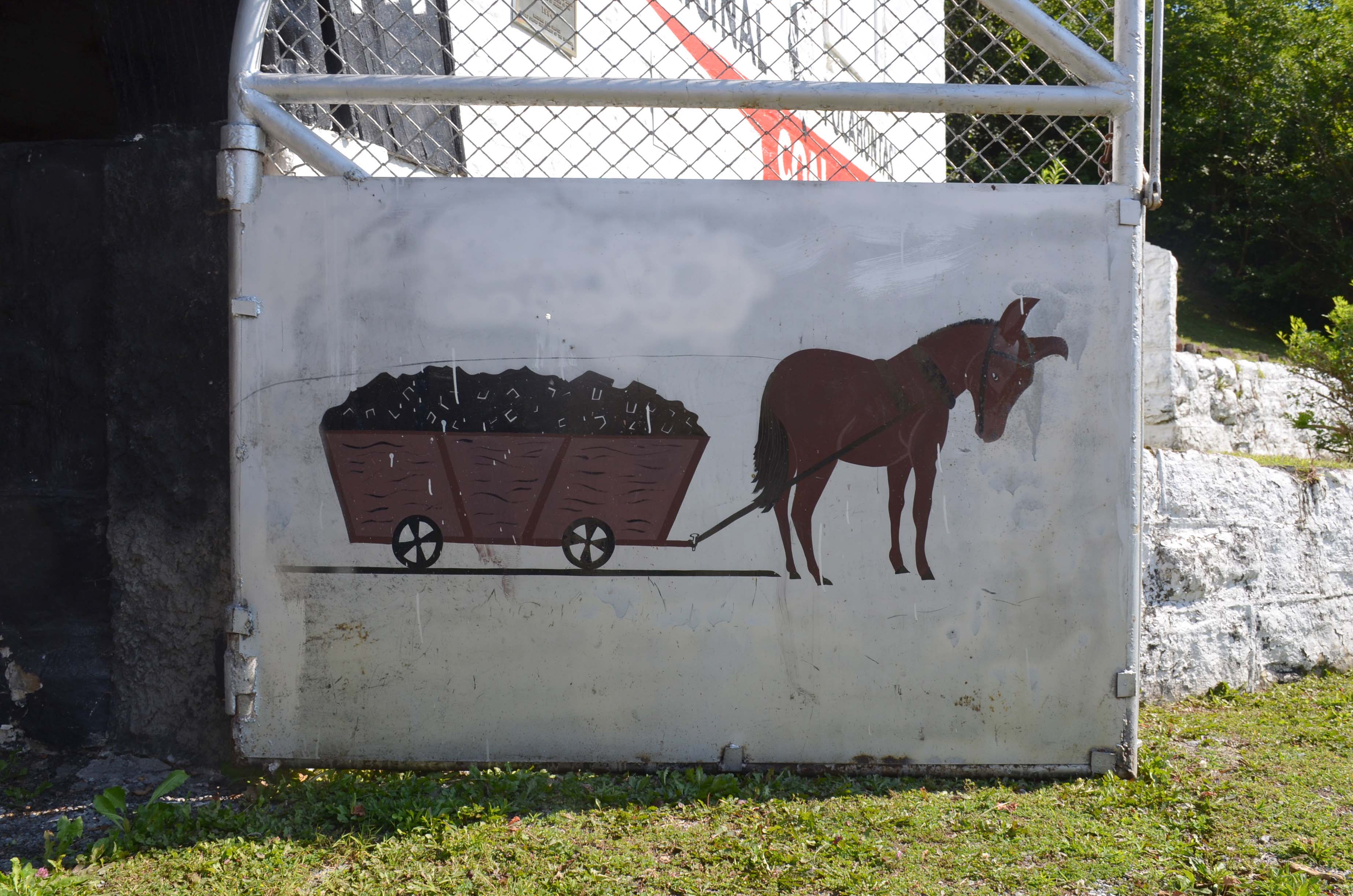
“I keep this door closed for dogs, kids, and bears,” our guide, Tammy, tells us as she opens the portal for the day. On the inside of the gate is a painting of a mule, memorializing the mine’s three hundred nonhuman laborers. The walking route makes a loop and exits through a different portal, likewise marking out a history of mining techniques and preserving some of the geological oddities—fossilized fish, kettle bottoms—that pervade the mines. In the 1960s and ’70s you could drive through the exhibition mine (the exhaust of the cars ended up eating away the varnished protection of the coal), and the signage and displays are still arrayed for vehicular viewing. This is decidedly high coal, with a range of around twelve to fourteen feet in height, and its proximity to the grade level of the valley outside made for comparatively easy work, if one could say such a thing about such hard and dangerous labor.
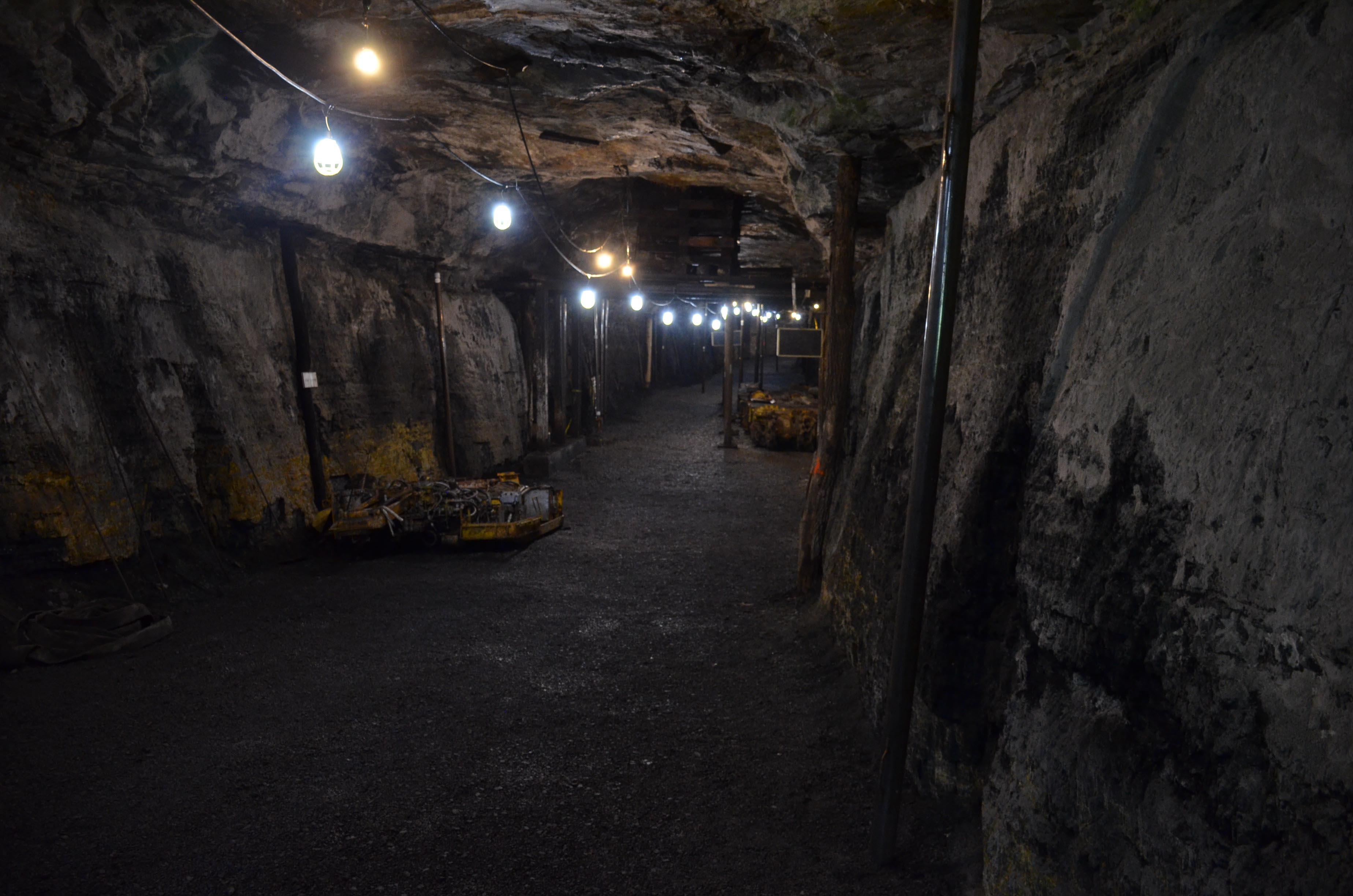
Tammy describes how the mining spreads out in a grid, leaving behind fat pillars of coal to help support the roof alongside wooden bracing, a subtracted hypostyle hall whose roof was the height of a given seam. Once the mine had reached its extents, the miners would reverse course, working their way from the outer edge back to the entrance, removing the bracing, removing those columns of coal, and folding the mountain back down on itself—as if that comparatively thin layer of geological time had been pulled out like a single card from a deck. The point of explaining the magic trick, one imagines, is to demonstrate sense of stewardship on the part of the mining industry. And yet it also speaks to a kind of human ingenuity, tempering the geological violence of pummeling through an anthracite seam with the image of gently lowering the rock roof until mountain meets mountain again. Such tidy closure was not the story for most exhausted seams, so take the story as you will. As Elizabeth Catte notes, narratives of folk stewardship have the tendency to confer “indigenous cultural traits” to white Appalachians, a complex tendency that can have opposite effects—obscuring native land rights by granting that stewardship to those who participated in the land’s expropriation, or encouraging indigenous/non-indigenous solidarities, as in the case of Appalachian activist support at Standing Rock.13
In my own visits to these exhibition mines, I found it hard to leave without a sense of admiration for the insane bravery of the job but also for a sense of something like craft—a closeness to the rock, cultivated over many long shifts inside the dark, seasonless depths of a mountain. If it’s important not to romanticize this imaginary coal miner, maybe it’s also important not to do the inverse—not to lose sight, even as we do all that we can to resist the extraction and burning of coal, of the knowledge that those laboring bodies contained within them, of the honesty, intelligence, and dexterity of the work that takes place within exploitative systems.
Leaving Pocahontas, I make the dubious decision to commit to the “crow flies” route to Madison, West Virginia (which, to Google Maps’ credit, it did not recommend). Ten miles out of town and I have exited AT&T country, leaving me with as much map as my phone had already loaded and a blue dot that triangulates haphazardly amid forest and rural roads. The pavement turns to gravel turns to lumpy dirt, and then all of a sudden, the road opens up into a blindingly sunlit terraced plain. I wonder for a split second whether I’ve crested the treeline—as on the balds farther southwest in the Grayson Highlands or the Smokies—before I quickly realize from the scarred terrain that I’ve blundered instead onto a mountaintop removal site. (Looking at maps later, I find that I’d passed a couple of miles from another penitentiary in a former mining site, the McDowell Federal Correctional Institute.) There’s a massive dump truck kicking up dry dust in the distance. I follow it discreetly down the other side of the leveled-off knob and am relieved that it leads me down to a coal preparation plant along the Pinnacle Creek. There are coal piles on both sides of the road, laced together with the usual tipples and spindly overhead conveyers that grab their way out into the landscape. Without stopping, I drive by a security gate whose guards look more mystified than suspicious that an early-2000s Honda Civic just came down from their mountain.
Mountaintop removal mining had been around before, but it entered widespread use during the energy crises of the 1970s. In a bitter irony, though, its contemporary growth in Appalachia owes something to the 1990 amendments to the Clean Air Act. To address acid rain and ozone depletion, the act called for the reduction of sulfur emissions, and as the historian Shirley Stewart Burns has documented, the mountains of southern West Virginia contained obligingly lower-sulfur coal that could be accessed from above.14 The 1977 Surface Mining Control and Reclamation Act mandates the landscape’s restoration to its “approximate original contour,” which results in a strange terracing and new growth of stripped lands (whose debris is likely choking the stream of a local hollow), as the landscape had been built from a literal-minded reading of a topographic map, with the contour lines marking steps instead of intersecting slopes.
“Pride of place and pride of occupation” is a phrase you’ll hear from time to time around a coal museum. How different the brutal realities of mountaintop removal are, with its draglines and dump trucks that hardly seem to belong to the occupational category of “mining” described in these museums.15 What is being historicized in such places is not this, and learning to untether the one from the other—for outsiders visiting, and for locals remembering—is one of the steeper challenges of the coal museum as a potential site for different kinds of stories.
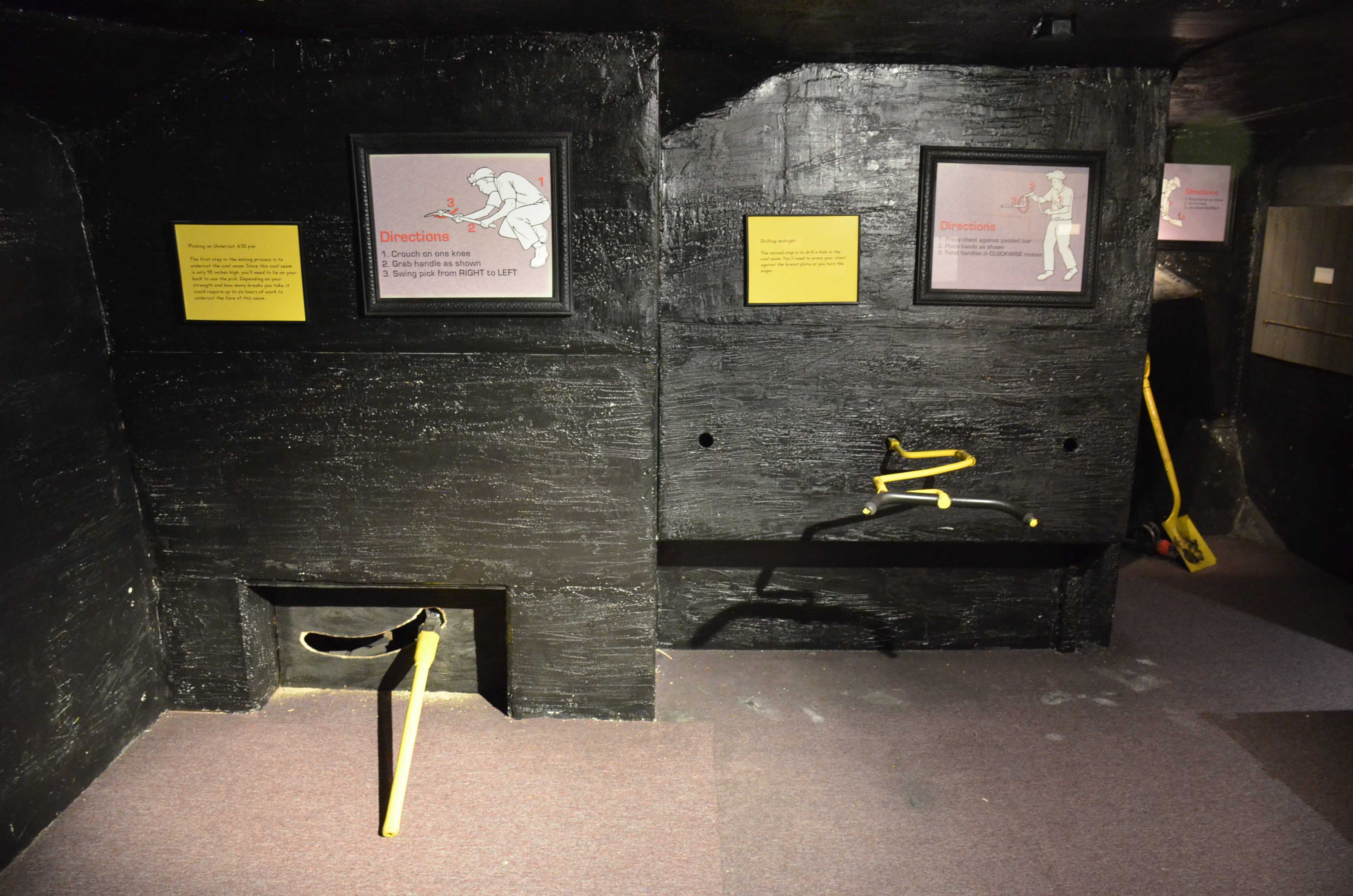
I next stop by a building that insists on thinking of coal at the scale of architecture—the so-called Coal House of Williamson, West Virginia. Like many cities and towns on the Tug Fork River, Williamson is surrounded by a prodigious flood wall courtesy of the Army Corps of Engineers; it’s the seat of Mingo County and hosts a substantial railyard on the southeast end of the city, a coal depot for the region’s mines. The Coal House was built in 1933 by the Norfolk & Western Railroad for publicity, a symbol of “the heart of the billion dollar coalfield,” as the town’s motto puts it. It is a work of novelty architecture, to be sure, crafted from heavily varnished coal blocks (the foundation is coal-black-painted stone). The interior burned in October 2010, but the coal managed not to, and it stands as a proud curiosity.
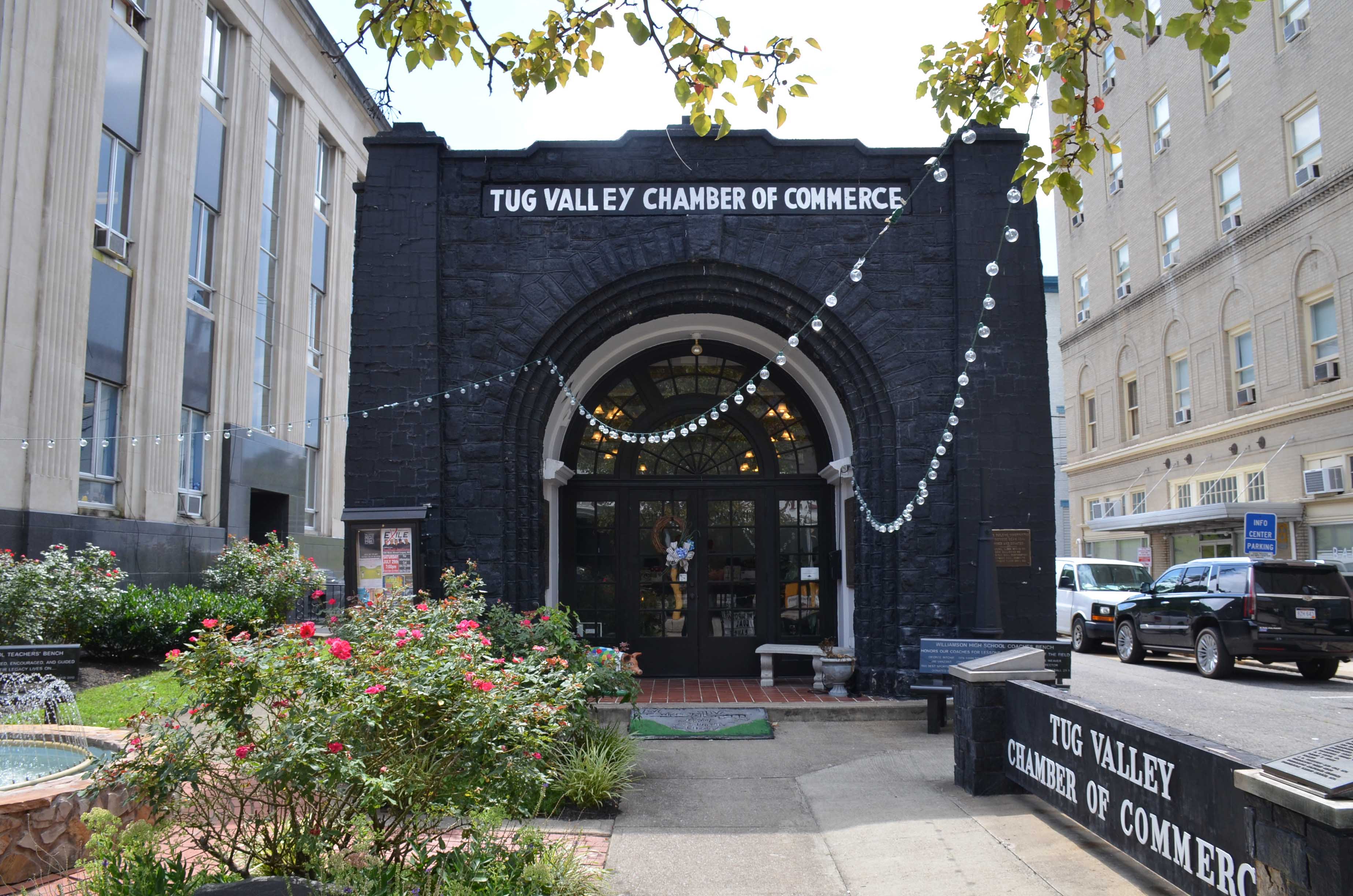
That evening, I stay in Matewan, famous for the Hatfield–McCoy feud but also the mine wars of 1920, whose story is told in a fairly recently opened museum. There is a tourist economy here, thanks mostly to the local network of ATV trails, though the town hopes for coal tourism as well. What seems most striking about Mingo County is how publicly many will acknowledge that coal isn’t coming back. A project called Sustainable Williamson, run by the Redevelopment Authority, began installing demonstration solar panels in 2011 and is looking to retool the economy toward renewables (“mining the sun” where the “billion dollar coalfield” once lay). My host, a descendent of the Hatfields, muses about whether embracing tech culture in the form of a “Silicon Holler” might bring back higher-salaried jobs—coal mining famously offering white-collar salaries for blue-collar labor. Perhaps more poignantly, the local union in Matewan, the United Mine Workers of America Local 1440, includes members committed to conservationist and labor-oriented political thought. The union, numbering 751 when I pass through, is comprised only of retirees, and as they pass on, the union goes with them.
It rains for most of my drive to Benham, Kentucky, hot summer showers that bring mist rising out of the hollows. A commercial country DJ encourages his listeners to “keep it out of the ditches” this weekend. When you enter Harlan County, there’s a highway sign that reads “Home of Jordan Smith, NBC’s The Voice Season 9 Winner.” No mention is made that Harlan County is the site of some of the most well-known labor actions in the history of the United States. Across the 1930s this was “Bloody Harlan,” a decade-long string of strikes, attacks, red-baiting, and occupations by state and federal troops, as well as a comparatively rare flourishing of explicitly pro-labor cultural artifacts. Florence Reece’s “Which Side Are You On?” is among the best-known union songs of the period, while Harlan Miners Speak, otherwise known as the Report of the Dreiser Committee, brought authors like Theodore Dreiser and John Dos Passos, in November 1931, to document the goings-on. Further strikes in 1973 are documented in Barbara Kopple’s Harlan County U.S.A., a vivid work of advocacy—bearing echoes of our present moment; many involved recall that the presence of cameras might have prevented more violence than what took place—and a staunchly principled reminder that the labor politics of coal have been, historically, about as close as the country has gotten to an embrace of socialism. This is part of the coal story too, even if the politics of the region today are a far cry from that era.
The Kentucky Coal Museum is in Benham, in the eastern reaches of the county. The museum has a claim to fame that it would rather it didn’t, as the national news media made considerable hay of the fact that it transitioned to solar power in 2017.16 I’m told by the welcoming staff that it was a decision by the local community college that operates the museum, that it will save them money, and that “telling the story” is the important part. There’s only irony in this if one assumes that telling the story of coal ought to require burning it too. Thanks to the building’s manufacturing-scaled ceiling heights, the museum excels at installed environments—a general store, a black-plastic-clad mine, a stable, and no shortage of models. Among the highlights is an extensive collection of Loretta Lynn memorabilia.
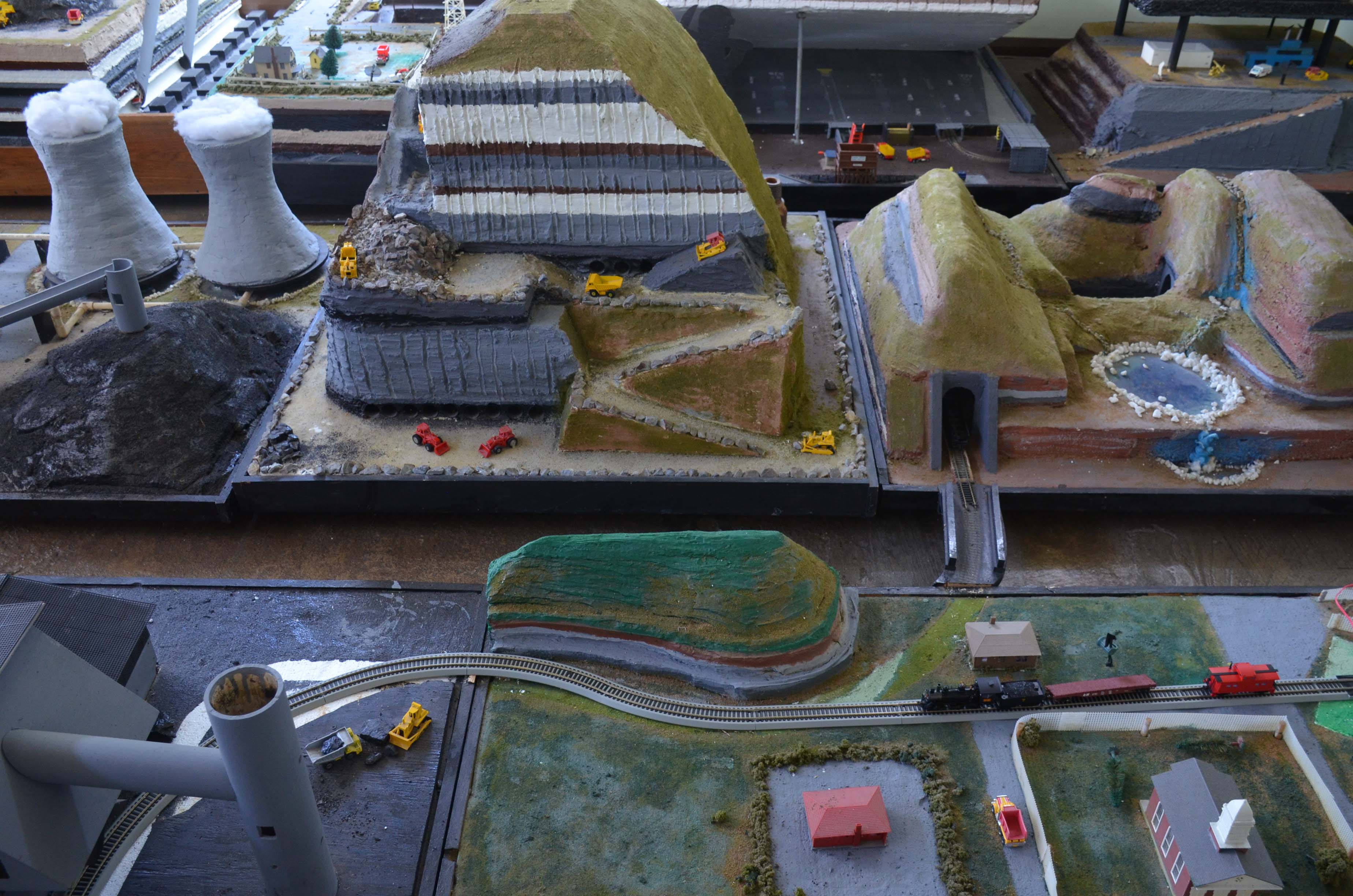
A few minutes up the Looney Creek is Lynch, named for the head of the US Coke and Coal Company when the camp was laid out in 1917. Lynch is the home to Portal 31, the most Epcotted of the Appalachian exhibition coal mines. I show up for the last tour of the day and I’m the only one there, which has to be a nuisance for the operator, though he doesn’t let on. The format is familiar to me now—an episodic ride on a mantrip that moves through a linear history of coal mining methods and the cultures that went alongside them. At Portal 31, that story is told through animatronic figures, timed projections, and pre-recorded dialogue, complete with caricatured accents when an Italian immigrant and his donkey take center stage to share methods of mining circa 1920. This is meant to be a generational story as much as a technological one; in a later diorama involving said immigrant’s son, the exhibition emphasizes a kind of pan-racial solidarity of underground labor, in which safety, teamwork, and the occupation of the earth’s depths are understood to contribute to race blindness. This solidarity was only grudgingly and belatedly extended to women (long held to be “bad luck” in the mines) and, even for the men, had little effect on the segregated lives of the miners aboveground.17
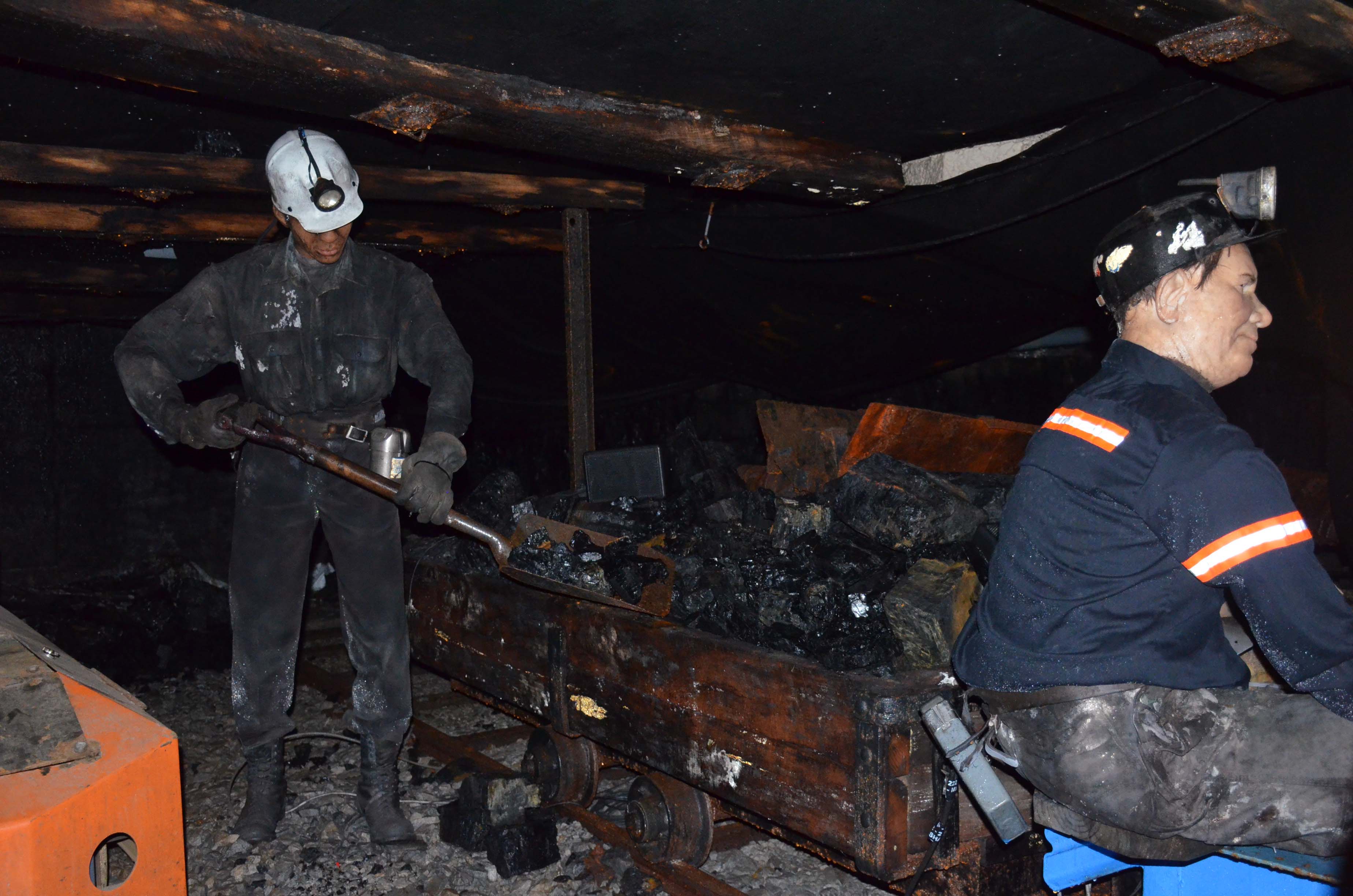
At the climax of this voyage into the coal seam—or, topographically speaking, the nadir, though the slope underground is far gentler than that of the knob above us—the train enters a somewhat larger carved-out chamber in which immersive projections, Spaceship Earth–style, take visitors back across geological time to consider the formation of the very rocks they’re currently occupying. There’s no small dose of the surreal, if not embarrassment, at being a grown adult by himself at the center of a visual bombardment that is almost certainly meant to be family entertainment, tracing a cartoon history of the earth’s crust. (The operator of the train, at this juncture, was staring blankly in the other direction, back into the inky cool humidity of the tunnels we came in from.) Back above ground, it’s easy enough to smile at the occasionally corny production and the story’s convenient omissions—of coal’s environmental effects locally and atmospherically, of the region’s racial politics, of the merciless opportunism of corporate resource extraction. But the fact of being there in the mine, feeling its peculiar atmosphere while being told an almost unfathomable history of how it all came to pass is a powerful thing in its own right and offers an experience that one might imagine harnessing toward other educative ends.
Much has been said about our collective failures of imagination in grasping the truths of climate change.18 In making extraction visceral, exhibition mines offer singular sites of possibility for understanding the earthliness of the atmospheric violence of capitalism, even if this isn’t necessarily the mission of such attractions today. Portal 31, it seems, is taken as the standard for Appalachian mine tourism—the exhibition mine at Pocahontas received a $1.5 million grant for renovations, citing their competition at Lynch as a model.19 It’s a mix of energy industry messaging and hometown pride that produces the narratives rehearsed inside them. But what other stories might be told in such an environment? How might the exhibition mine help understand the Appalachian landscape both as a sacrifice zone of human and geological exploitation, and as a crucial site of culture and knowledge? Questions like these would necessarily complicate the current imaginaries of the coal miner and the coal seam, replacing their political fictions with more genuine histories of labor and environment. The theorist Kathryn Yusoff asks us “to burrow deep into the unknown regions of barely visible affiliations with fossil fuels, into the affectual architectures of its mines, and across the cuts of mutual exposure, turning toward its inheritance, as it would do toward the sun (its solar origin), and into the emergence of a language that seeks out the radically nonlocal in gestures of solidarity.”20 Perhaps, in making coal historical, we should take this call as literally as possible.
-
Kathryn Yusoff, “Queer Coal: Geneaologies in/of the Blood,” PhiloSOPHIA, vol. 5, no. 2 (Summer 2015): 203. ↩
-
IPCC, “Global Warming of 1.5˚C” (Intergovernmental Panel on Climate Change [IPCC], 2018), link. See also Coral Davenport, “Major Climate Report Describes a Strong Risk of Crisis as Early as 2040,” the New York Times, October 7, 2018, link; Somini Sengupta, “The World Needs to Quit Coal. Why Is It So Hard?” the New York Times, November 24, 2018, link. ↩
-
Jay Apt, “The Other Reason to Shift Away from Coal: Air Pollution that Kills Thousands Every Year,” Scientific American, June 7, 2017, link. ↩
-
“Coal Explained: Where Our Coal Comes From,” US Energy Information Administration, link. ↩
-
These numbers are drawn from the US Department of Labor’s published statistics on “Coal Fatalities for 1900 through 2017,” which includes figures for total mining employment, link. ↩
-
Jennifer Ludden, “Coal Jobs Have Gone Up under Trump, but Not Because of His Policies,” NPR, February 23, 2018, link. ↩
-
Elizabeth Catte, What You Are Getting Wrong about Appalachia (Cleveland: Belt Publishing, 2018), 121–124. ↩
-
Catte, What You Are Getting Wrong about Appalachia, 132. ↩
-
Keith Frye, Roadside Geology of Virginia (Missoula: Mountain Press Publishing Company, 1986), 225–228. ↩
-
Being less dependent on labor, the coal companies have little reason to control it in the ways it once did. But the typology remains in other forms, whether in the “man camps” of fracking or the <i>kafala</i> system of construction labor. ↩
-
For a quick primer, see “Coal-Mining and Protest Music,” Encyclopedia of Appalachia, 2018. Or if you’d like some background listening, link. ↩
-
Catte, What You Are Getting Wrong about Appalachia, 124. ↩
-
Shirley Stewart Burns, Bringing Down the Mountains: The Impact of Mountaintop Removal Surface Coal Mining on Southern West Virginia Communities, 1970–2004 (Morgantown: West Virginia University Press, 2007), 6–8. ↩
-
Among many other accounts, see Jedediah Purdy, “The Violent Remaking of Appalachia,” the Atlantic, March 21, 2016, link.
The Coal Heritage Museum in Madison, West Virginia, is a downtown storefront, which, like other such museums, has become something of a community space for the attendants and their friends. There is a sense of daily checking-up between the women who sit on folding chairs as they host stray visitors. It is a familiar collection, by this point in my trip, of objects, outfits, print media, and models. Madison’s museum emphasizes the barging of coal more than other museums, with exhibits on the locks along the Coal River, connecting to the Kanawha and eventually the Ohio. But the innovation here is in the basement, which has been outfitted to resemble a coal mine. In each room, one finds devices that are somewhere between mining tools and exercise equipment—coal as calisthenics—where you’re meant to feel the weight of the work, the cramped awkwardness of the struggle against the rock. A tour through the basement is, in fact, a fairly thorough workout. I’m reminded of something said in the Pocahontas mine: “Ain’t nothing built for a coal miner built for comfort.” The architectures of coal take form at the scale of the mountain but also at the scale of the body. ↩ -
Alexandra Larkin, “Kentucky Coal Museum Switching to Solar Power,” CNN, April 6, 2017 link. ↩
-
On women’s labor in the mines, see Marat Moore, “Hard Labor: Voices of Women from the Appalachian Coalfields,” Yale Journal of Law and Feminism, vol. 2, no. 2 (1989): 199–238. On race and coal, see Joe William Trotter Jr., Coal, Class, and Color: Blacks in Southern West Virginia, 1915–32 (Urbana: University of Illinois Press, 1990). ↩
-
Among the most frequently summoned touchstones are Bill McKibben, “Imagine That: What the Warming World Needs Now Is Art, Sweet Art,” Grist, April 21, 2005; Amitav Ghosh, The Great Derangement: Climate Change and the Unthinkable (Chicago: University of Chicago Press, 2016). ↩
-
Charlie Boothe, “Pocahontas Exhibition Coal Mine to See Major Renovations Thanks to $1.5 million Award,” Bluefield Daily Telegraph, May 12, 2018, link. ↩
-
Yusoff, “Queer Coal,” 227. ↩
James Graham is the Director of Columbia Books on Architecture and the City and founding editor of the Avery Review. His website is www.jmzgraham.com.

